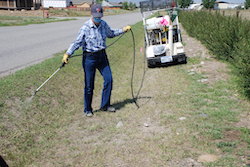1.800.858.7378 npic@ace.orst.edu
We're open from 8:00AM to 12:00PM Pacific Time, Mon-Fri
About us ![]()
![]()
1.800.858.7378 npic@ace.orst.edu
We're open from 8:00AM to 12:00PM Pacific Time, Mon-Fri
About us ![]()
![]()

Prodiamine is an herbicide that works by preventing cells in plants' roots and shoots from dividing. It is low in toxicity to people. It does not dissolve well in water and binds tightly to soil. It breaks down slowly in soil, but rapidly if exposed to sunlight or if it is in water. Prodiamine is low in toxicity to bees and other beneficial insects but moderately toxic to earthworms. It is toxic to some aquatic animals. The U.S. Environmental Protection Agency (U.S. EPA) considers prodiamine a "possible human carcinogen."

Prodiamine belongs to a group of human-made herbicides called dinitroanilines. Prodiamine is used in non-crop areas, nurseries, golf courses, and residential land.1 It was first registered for use in 1992.2 Prodiamine is used to control annual grasses and broadleaf weeds.3,4 Prodiamine is a selective herbicide that can be used before planting or emergence.4,5
There are over 500 pesticide products that contain prodiamine.6 Prodiamine is sometimes used in products with other herbicides. Some products with prodiamine might also contain fertilizers. Prodiamine is used as a dust, emulsifiable concentrate, soluble concentrate, water dispersible granule, dry flowable, flowable concentrate, granular, or ready-to-use product.6,7
Prodiamine is not used in organic horticulture.8
|
Technical Grade Prodiamine: This fact sheet refers to the technical grade, or "pure" prodiamine only. Products you buy from the store include other ingredients as well. While many of the chemicals used as other ingredients may not pose health or environmental risks, some of them can be toxic. In some cases, the other ingredients can pose greater risks than the active ingredient itself. |
Prodiamine interferes with cell division to stop root and shoot growth.9
You could be exposed to prodiamine while using a product or if you are too close to an application. You could breathe it in, get it on your skin, or get it in your eyes. You could be exposed if you eat or smoke after making an application without washing your hands. Granules could be mistaken for food crumbs by pets or children. Prodiamine is not used on any food crops, so it is not expected to be a residue on food.7,10 Prodiamine may occur at low concentrations in drinking water.7
IMPORTANT: Always follow label instructions and take steps to minimize exposure. If any exposures occur, be sure to follow the First Aid instructions on the product label carefully. For additional treatment advice, contact the Poison Control Center at 800-222-1222. If you wish to discuss a pesticide problem, please call NPIC at 800-858-7378.

If inhaled, prodiamine is low in toxicity.7
If eaten, prodiamine is very low in toxicity.7
When it gets on the skin, prodiamine is low in toxicity.7
If prodiamine gets in your eyes, it can cause mild eye irritation and redness.11
Based on numerous studies and data, it is unlikely that prodiamine is neurotoxic.7,12 However, in one rat study, rats fed 2000 mg/kg of prodiamine were less alert and had reduced movements 5 hours after exposure.12
For more information about how NPIC finds scientific studies, see our page on Writing NPIC Fact Sheets.
| TOXICITY CLASSIFICATION - PRODIAMINE7 (see the text box about mg/kg) | ||||
|---|---|---|---|---|
| High Toxicity | Moderate Toxicity | Low Toxicity | Very Low Toxicity | |
| Acute Oral LD50 | ≤ 50 mg/kg | > 50-500 mg/kg | > 500-5000 mg/kg | >5000 mg/kg |
| Inhalation LC50 | ≤ 0.05 mg/L | > 0.05-0.5 mg/L | > 0.5-2.0 mg/L | > 2.0 mg/L |
| Dermal LD50 | ≤ 200 mg/kg | > 200-2000 mg/kg | > 2000-5000 mg/kg | > 5000 mg/kg |
| Primary Eye Irritation | Corrosive (irreversible destruction of ocular tissue) or corneal involvement or irritation persisting for more than 21 days | Corneal involvement or other eye irritation clearing in 8 - 21 days | Corneal involvement or other eye irritation clearing in 7 days or less | Minimal effects clearing in less than 24 hours |
| Primary Skin Irritation | Corrosive (tissue destruction into the dermis and/or scarring) | Severe irritation at 72 hours (severe erythema or edema) | Moderate irritation at 72 hours (moderate erythema) | Mild or slight irritation at 72 hours (no irritation or erythema) |
|
The shaded boxes reflect signs and symptoms observed after a brief exposure. Modeled after the U.S. Environmental Protection Agency, Office of Pesticide Programs, Label Review Manual, Chapter 7: Precautionary Statements. https://www.epa.gov/sites/default/files/2018-04/documents/chap-07-mar-2018.pdf. You may be wondering why the "High Toxicity" column has smaller numbers than the "Low Toxicity" column. This is because if a smaller amount of the pesticide caused a health effect, it's more toxic. If it takes a larger amount of the pesticide to cause a health effect, it's less toxic. |
||||
What is a mg/kg?"Mg/kg" is a way to measure a chemical dose. This can tell us how toxic a chemical is. "Mg" means milligrams of a chemical. "Kg" means one kilogram of an animal's body weight. Something that is highly toxic may kill a person with a very small amount of chemical. If something is very low in toxicity, it may take much more for that same person to become very sick or die. For more information, see the Pesticide Hazard vs. Risk Fact Sheet. |
When prodiamine enters the body, it is rapidly excreted. After 24 hours, rats eliminated around 70% of the total dose. Most of the prodiamine was detected in the feces. The amount found in tissue 4 days later was 0.5-1.4% of the initial dose.13
Researchers gave rats a single dose of either 10 mg/kg or 400 mg/kg prodiamine. They also fed the rats daily with 10 mg/kg prodiamine for 2 weeks. In all cases, the rats had eliminated the prodiamine within 4 days after feeding had stopped. Female rats had higher tissue levels of prodiamine. The residues were found throughout the body. Most of the dose was eliminated in the feces and urine.7
There are no studies available on dermal absorption, or how well prodiamine passes through the skin. However, the U.S. EPA used a related chemical to estimate dermal absorption. Based on that, they expect 3% would be absorbed by the skin into the body.7
The U.S. EPA classifies prodiamine as a "Group C - Possibly Carcinogenic to Humans" based on thyroid tumors in male and female rats.7 Prodiamine did not cause cancer in mice.3,7,14 Prodiamine was negative for mutagenicity in all available studies. However, the U.S. EPA determined that it is plausible that two of the breakdown products of prodiamine are carcinogens and mutagens.7
The target organ of prodiamine in animals is the thyroid.7 This means the thyroid is the organ most likely to be harmed if an animal is exposed. Researchers have not identified a specific target organ in humans. However, prodiamine can affect the liver, thymus gland, and thyroid gland.15
What is part per million (ppm)?Parts per million (ppm) is a unit of chemical measurement. One ppm is one part of the chemical to one million parts of water, soil, or food. Although 1 ppm is equivalent to 1 mg/ kg, mg/kg refers to the amount of chemical (in milligrams) per kilogram of body weight, not the concentration in food in a toxicity study. One ppm may also be written 1 mg/L if the substance is a liquid. It is a very small concentration. |
When researchers fed rats prodiamine at 0, 400, 1200, or 4000 parts per million (ppm) for 13 weeks, the rats had effects at the highest dose of 4000 ppm in their food. At that dose, the rats gained less body weight, had increased cholesterol, and had increased urinary protein content.3 Rats eating 4000 ppm prodiamine for 13 weeks also ate less than rats in the other groups and their kidneys and livers were heavier. No effects were observed at 1200 ppm (80 mg/kg body weight) based on the effects seen at the highest dose of 4000 ppm.13
When beagle dogs ate prodiamine at either 0, 200, 600, or 2000 ppm for 13 weeks, dogs that were fed 600 ppm had changes in their blood. Dogs fed the highest dose of 2000 ppm had changes in their blood, heavier livers, liver damage, and their reproductive organs weighed less. Researchers did not see any changes in the dogs fed 200 ppm (5 mg/kg body weight).13
In another study, beagle dogs who ate 2000 ppm per day of prodiamine for 52 weeks had heavier livers and changes in blood chemistry compared to dogs that ate less or none.13
No human studies were found on the long-term effects of prodiamine.
Children are at an increased risk to pesticides due to their smaller body size, ongoing organ development, and different behaviors. Keep all pesticides out of reach of children and pets to avoid accidental ingestion.
Young children may act in ways that put them at greater risk of being exposed. For example, they may spend more time near the floor. They may also be more likely to place their hands in their mouths after touching treated surfaces or pets. The U.S. EPA concluded that prodiamine should not be more toxic to children than adults and no additional safety factors in the risk assessments were needed.16
Researchers found a birth defect called omphalocele after feeding pregnant rats 300 mg/kg of prodiamine. This is a defect where organs stick out through the abdominal wall. Pregnant rats and rabbits fed 1000 mg/kg and 300 mg/kg respectively gained less weight than unexposed pregnant rats and rabbits.3

Prodiamine is broken down quickly by sunlight.5,9 It is not likely to leach or reach groundwater.17,18 Prodiamine is not soluble in water.17 The half-life of prodiamine in water exposed to sunlight is very short, ranging from 2.3-7.3 hours. The half-life of prodiamine in aerobic water conditions is around 18.3-24.9 days.18
Prodiamine binds tightly to soil and breaks down slowly in soil. The half-life of prodiamine in sandy loam soil is around 69 days.5
Prodiamine is not very likely to become a gas based on its vapor pressure (2.50x10-8 mmHg @ 25°C / 77°F).18
Pesticides that enter the environment can affect wild plants and animals. Prodiamine has a potential to bioaccumulate in aquatic organisms.18
Birds
Birds might be exposed to prodiamine by eating granules, feeding on exposed prey, or by contact with a pesticide product containing prodiamine. Water containing trace amounts of prodiamine is not expected to be toxic to birds.18
Aquatic animals
Prodiamine is practically insoluble in water. This makes it difficult for researchers to accurately measure how much is in water when they run tests and look for impacts to aquatic organisms.13 However, the amount that can dissolve is low in toxicity to fish. Overall, scientists saw reproductive effects in freshwater fish and invertebrates exposed to prodiamine. However, none of the animals died during tests.18
Bees
Prodiamine is low in toxicity to honeybees following contact and slightly toxic following ingestion.13,18 More data may be needed to fully evaluate risks to pollinators, especially chronic exposure to bees.19
Worms and insects
Prodiamine is low to moderately toxic to earthworms.13,20
Prodiamine does not affect the development of other beneficial insects.13
Soil microorganisms were not affected when scientists treated their soil with prodiamine for 28 days. The soil type was sandy loam.13
For more detailed information about prodiamine, please visit the list of referenced resources below or call the National Pesticide Information Center, Monday - Friday, 8:00am - 12:00pm Pacific Time (11:00am - 3:00pm Eastern Time) at 800-858-7378. NPIC provides objective, science-based answers to questions about pesticides.
Please cite as: Kent, L.; Cross, A; Gervais, J.; Cocks, M.; Jenkins, J. 2023 Prodiamine Fact Sheet; National Pesticide Information Center, Oregon State University Extension Services. npic.orst.edu/factsheets/prodiamine.html.

NPIC fact sheets are designed to answer questions that are commonly asked by the general public about pesticides that are regulated by the U.S. Environmental Protection Agency (U.S. EPA). This document is intended to be educational in nature and helpful to consumers for making decisions about pesticide use.